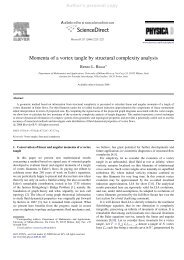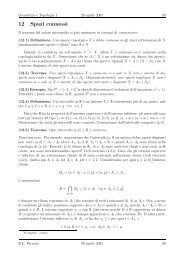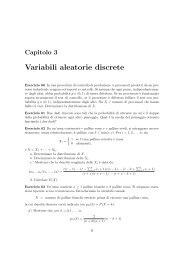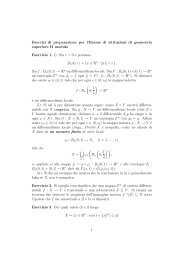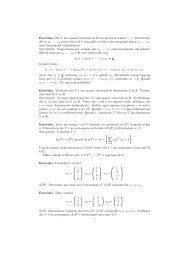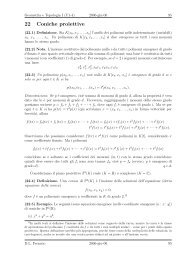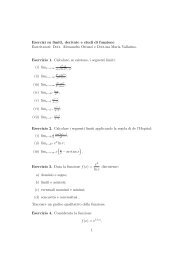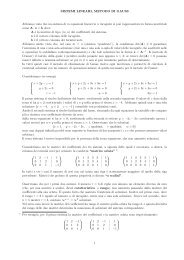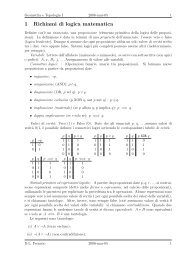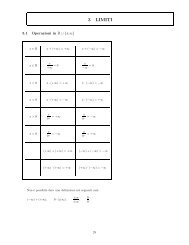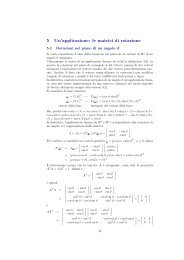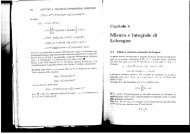Geometria I 176§ <strong>19</strong>.1 Isomorfismi <strong>proiettivi</strong> e <strong>proiettivi</strong>tà(<strong>19</strong>.17) Definizione. Siano P(V ) e P(W ) due spazi <strong>proiettivi</strong>. Una funzione f : P(V ) →P(W ) si dice proiettiva se esiste un omomorfismo iniettivo di spazi vettoriali F : V → W taleche per ogni v ∈ V si ha f([v]) = [F (v)].V {0}P(V )FfW {0} P(W )Si dice che F induce la funzione f. Se f ammette una inversa proiettiva g (cioè una funzioneg : P(W ) → P(V ) indotta da un omomorfismo iniettivo G: W → V tale che gf =1 P(V ) efg =1 P(W ) ), allora è detto un isomorfismo proiettivo. In questo caso si dice che P(V ) e P(W )sono isomorfi. Se V = W (e quindi P(V )=P(W ), allora un isomorfismo proiettivo si dice<strong>proiettivi</strong>tà.Osserviamo che diverse F possono indurre la stessa funzione proiettiva f : P(V ) → P(W ):infatto se F : V → W induce f, allora anche λF , per λ ≠0, λ ∈ K, induce la stessa f.(<strong>19</strong>.18) Due omomorfismi F, G: V → W iniettivi inducono la medesima f : P(V ) → P(W )se e soltanto se esiste λ ∈ K ∗ tale che G = λF . La funzione f è un isomorfismo se e soltantose F : V → W è un isomorfismo di spazi vettoriali, per una qualsiasi F che induce f.Dimostrazione. Abbiamo già visto che se G = λF , allora inducono la stessa f. Viceversa, seF e G inducono la medesima f, allora per ogni v ∈ V deve esistere λ v ∈ K ∗ tale cheSe v e w sono due vettori di V , allorae dunqueG(v) =λ v F (v).G(v + w) =λ (v+w) F (v + w),G(v)+G(w) =λ (v+w) (F (v)+F (w).Ma G(v) =λ v F (v), G(w) =λ w F (w), e quindi deve essereλ v F (v)+λ w F (w) =λ (v+w) F (v)+λ (v+w) F (w).Se v e w sono linearmente indipendenti, allora anche F (v) e F (w) lo sono, e quindiλ v = λ (v+w) = λ w .Se v e w sono linearmente dipendenti, allora è facile vedere che λ v = λ w . Quindi esiste λ (chenon dipende da v) tale che G(v) =λF (v) per ogni v ∈ V .
Geometria I 177Ora, se f è un isomorfismo proiettivo (indotta da F ), allora esiste la sua inversa g (indottada G). La composizione GF induce l’identità di P(V ), la composizione FG induce l’identitàdi P(W ), e quindi devono esistere λ e λ ′ tali cheGF = λ1 V , F G = λ ′ 1 W ,e F deve essere un isomorfismo di spazi vettoriali.(<strong>19</strong>.<strong>19</strong>) Nota. Due spazi vettoriali della stessa dimensione (su campo K) sono isomorfi, percui due spazi <strong>proiettivi</strong> sullo stesso campo e con la stessa dimensione sono isomorfi. Quindisenza perdere in generalità si può sempre pensare che uno spazio proiettivo su campo K siaP n (K). Se indichiamo con GL(V ) il gruppo di tutti gli isomorfismi dello spazio vettorialeV in sé e P GL(V ) il gruppo di tutte le <strong>proiettivi</strong>tà di P(V ) in sé, si ha un omomorfismo(di gruppi) GL(V ) → P GL(V ) suriettivo (per definizione) ma non necessariamente iniettivo.Come abbiamo visto prima, il suo nucleo è proprio dato dall’insieme di tutti i multipli di 1 V(identità di V ) del tipo λ1 V , con λ ∈ K ∗ . Possiamo ripetere passo per passo l’argomentousato: se A: V → V induce l’identità P(V ) → P(V ), allora per ogni v ∈ V si ha Av = λ v vper un certo λ v ∈ K (che potrebbe dipendere da v), λ v ≠0: cioè tutti i vettori di V sonoautovettori per A. Ora, se v ′ = v + w, si haAv ′ = Av + Aw=⇒ λ v ′v ′ = λ v v + λ w w=⇒ λ v ′(v + w) =λ v v + λ w w=⇒ (λ v ′ − λ v )v +(λ v − λ w )w =0,e quindi quando v e w sono linearmente indipendenti deve essere λ v = λ v ′ = λ w . Dato cheautovettori linearmente dipendenti hanno sempre lo stesso autovalore, deduciamo che λ v nondipende da v, e quindi che Av = λv, cioè A = λ1 V .Le matrici del tipo λ1 V costituiscono il centro di GL(V ). Il centro di GL(n, K) ∼ = GL(V )è il sottogruppo di tutte le matrici A tali che AB = BA per ogni B ∈ GL(V ). Sia ora E ijuna matrice con coefficienti ovunque 0 tranne 1 al posto ij, con i ≠ j. La matrice I + E ijha determinante 1, e quindi è invertibile. In particolare, se A è nel centro di GL(V ), deveessere A(I + E ij ) = (I + E ij )A per ogni scelta di ij, e quindi AE ij = E ij A. Ma AE ij è unamatrice che ha zeri ovunque tranne nella colonna j-esima (dove compare la i-esima colonna diA). Invece, E ij A ha zeri ovunque tranne nella riga i-esima (dove compare la j-esima riga diA). Quindi la matrice AE ij = E ij A ha tutti zeri tranne nel posto ij; nella j-esima colonna c’èla i-esima colonna di A, che quindi deve avere tutti zero tranne il coefficiente a ii , che comparein AE ij al posto ij; nella i-esima riga di AE ij c’è la j-esima riga di A, che quindi deve averetutti zero tranne il coefficienti a jj , che compare in AE ij al posto ij. Quindi A è una matricediagonale con a 11 = a 22 = . . . = a nn , cioè A = λI.(<strong>19</strong>.20) Definizione. Si dice che sottoinsiemi S, S ′ ⊂ P n (K) sono proiettivamente equivalentise esiste una <strong>proiettivi</strong>tà f : P n (K) → P n (K) tale che f(S) =S ′ .(<strong>19</strong>.21) Esempio. Quali insiemi di 2 punti sono proiettivamente equivalenti in P 1 (R)? Qualiin P 1 (C)?qed



